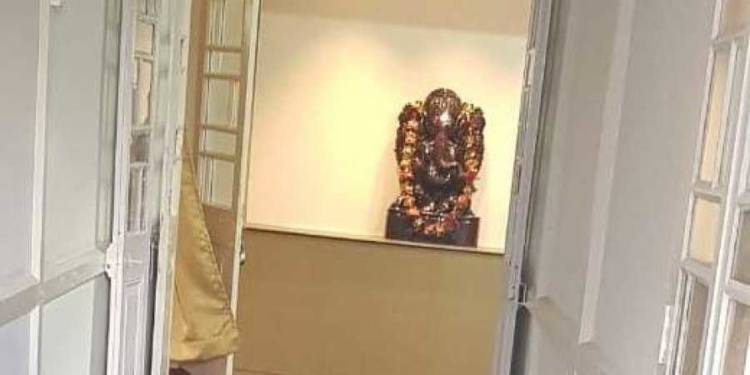Very recently, comedian Abhineet Mishra shared a rather moving post about Shillong and the diversity which it exemplifies, which is evident by the grandeur in which both Durga Puja and Christmas are celebrated in the city. As a Shillongite, and one who has seen much of the ‘diversity’ here, I had mixed opinions about the same. We would like Shillong to be the way it is thought to be, however, the reality on ground reflects a rather disturbing picture.
I do admit that comparatively, the discrimination and hate meted out towards the non-indigenous citizens of the state has reduced when one looks at the present and the years that have gone by. However, that does not imply ‘all is well’. Roughly 11% of Shillong’s population consists of what we are called ‘dkhars’ or ‘non tribals’, and the troubles faced by them in this state for decades have never attracted any national attention, even though the problems revolve around xenophobhia and religious discrimination.
The Hindustan Times today reported that a Ganesh idol was asked to be removed from NIT Meghalaya, a central educational institution. Who put forward this demand? The ‘local student bodies’. In just three days, the Jaintia Students’ Union objected to the idol as it would “incite communal sentiments” among the students and staff belonging to other faiths. Student unions in Meghalaya can wreak havoc in the lives of people who disagree with them, and often it has nothing to do with students. With this tendency, when Jaintia Student Union protests vehemently and says this can ‘incite communal sentiments’, they mean it will definitely lead to trouble and violence because they will ensure it. The intolerance, no matter how unsurprising, is a blot on Meghalaya’s society. It is disheartening to see that even in 2019, nothing has really changed and ‘dkhars‘ are still shown their place whenever it deems fit for certain elements to do it.
NIT Meghalaya was also in the news for xenophobia a few months ago following a brawl inside the campus between the local and non-local students. This escalated into a mob-like situation when a bus full of NIT students (from other states) was stopped and the students inside were thrashed. One can take a guess as to who consisted the mob which attacked the students. Of course like all other incidents which transpire here, there are two conflicting versions. It is best to not get into the version game. Whatever the version may be, it is not justified to harass students to an extent that they are forced to think about fleeing the state. Also, mind you, not one liberal soul across the country screamed ‘minorities are under attack’ when this incident took place.
However, the latest move by the Jaintia Student Union to ask for the removal of a Ganesha idol is an outright infringement of the fundamental right to religion and worship of all those concerned. What business do these student bodies have to dictate which statue is to be placed and which statue is not worthy of being placed inside the campus? I am very sure that come Christmas, NIT Meghalaya will put up a Christmas tree to join the fervour in the state. What if someone then complains about the installation of a Christmas tree, or the portrait of Jesus Christ? Will these student bodies take it lying down?
The vast majority of children in Shillong are educated in convent and missionary schools, where one finds Christ’s portrait and the Cross installed in every classroom and busts of Saints at the entrance of institutions. Oh, the one way street that is secularism in India. We never really bothered as to what morning prayers we were made to recite, the ‘Lord’s Prayer’ every morning never invited protest from the minorities in Meghalaya. However, will this mutual respect and tolerance for each other’s faith always be unilateral? Does the majority community here, specifically the student bodies, not think it to be a responsibility on their part to also accept the faith of others? Article 30 of the Constitution provides for minority communities to run and administer educational institutions freely, and often discriminate, and at the same time this ‘right’ strips the majority community of the same privilege. To be fair, the people of the state are not as much intolerant as compared to these student bodies, which, due to their political compulsions, and also to stay in relevance, indulge in these cheap theatrical acts, often leading to further division among the people based on their race and community. The history of Meghalaya, which people loosely refer to as a ‘Christian’ state, is replete with incidents of mass riots and communal flare ups, often stemming from a sense of ‘right over this land’ syndrome.
This also goes on to prove how the word ‘minority’ has been concocted to suit specifically only two communities in India. The harassment of Hindus or Sikhs or any other Indic community, when they are in minority, simply does not qualify to be news and outrage worthy.
The administration of NIT, instead of standing up to this authoritarianism, simply removed the Ganesha idol. What would have been admirable, would be for them to protect the right of their institutional autonomy, and also the right of worship of their mostly non-Christian students. The ‘spirit of Shillong’ would be well served when one really understands that tolerance and mutual respect are not a one-way street.































